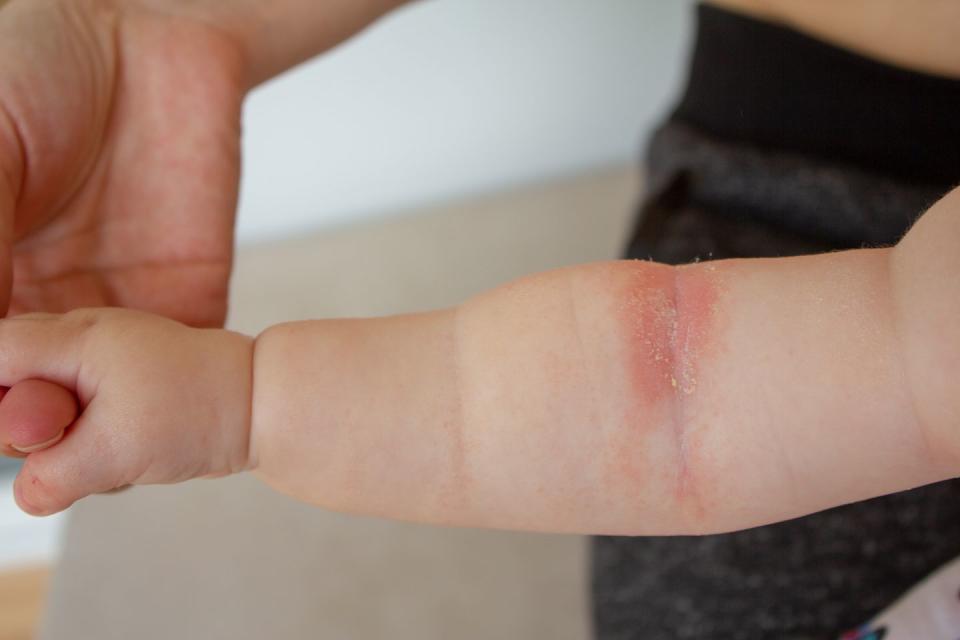5 Surprising Truths About Peanut Allergies You Need to Know

Peanut allergies—already one of the most common in children these days—are on the rise. They’ve increased by 21 percent since 2010 and impact upwards of 6.1 million people around the world. Yet despite how prevalent the condition is, there are still a lot of misconceptions that many people (even doctors!) don’t talk about.
Here, Mark Holbreich, MD, a board certified allergist practicing in Indianapolis, Indiana, and a fellow of the American Academy of Allergy, Asthma and Immunology, shares five little-known facts about peanut allergies. The info will help you better protect yourself and your loved ones, whether or not you have a peanut allergy in the family. Because chances are, you know someone who’s allergic, and the more informed you are, the safer everyone is.
Fact No. 1: Many kids who develop peanut allergies had eczema as babies.
Ever wonder why some kids develop peanut allergies, and others don’t? Experts believe it has to do with exposure to peanuts through damaged skin—before solid foods are even introduced, says Dr. Holbreich. “In babies with atopic dermatitis—a.k.a. eczema—the skin is scaly and itchy,” he says. When peanut protein comes in contact with a baby’s impacted skin, it can enter the bloodstream and create a food allergy or sensitivity, says Dr. Holbreich. (In fact, most food allergies, including egg, soy, wheat, and cow’s milk, develop this way, after initial exposure via the skin.)

Peanut protein is resilient. It can spread easily throughout a home and is even resistant to standard cleaning methods, according to research published in The Journal of Allergy and Clinical Immunology—so in homes where peanuts are eaten exposure is very likely. And while that’s not necessarily a bad thing (not all babies with eczema go on to develop peanut allergies!), it may explain why peanut allergies develop in the first place.
Fact No. 2: Trace amounts of peanut exposure are unlikely to cause a severe reaction.
If you have a child with a peanut allergy, it can be tempting to steer clear of all products with any trace of peanuts, completely avoiding what experts call “precautionary labeling.” However, food labels that say things like “May contain peanuts,” “Trace amounts of peanuts,” or “Manufactured in a facility with peanuts” are probably OK, says Dr. Holbreich.
According to one study published in the World Allergy Organization Journal, only 10 percent of products that list “may contain peanuts” have detectable peanut protein. “Fear about food allergy is a problem, and some health professionals feed into this by making dire predictions about accidental reactions,” says Dr. Holbreich. “I reassure families that a peanut allergy is manageable with reasonable precautions,” such as avoiding peanuts and foods containing them but not worrying too much about trace amounts. However, he notes that the advice on precautionary labels can vary significantly from specialist to specialist. “Always rely on the advice your provider gives you,” he says.
Fact No. 3: Death from peanut allergies is very rare.
If you or a loved one is allergic to peanuts or another food, the fear of a fatal reaction is real. Yet while up to 5 percent of the U.S. population has suffered from anaphylaxis—a severe, potentially life-threatening allergic reaction that can occur within seconds of exposure to something you’re allergic to—the risk of fatal anaphylaxis is less than 1 percent. “For many parents, there’s a strong fear that their child can die from peanut ingestion," says Dr. Holbreich. "But when you look at the statistics, it’s an extremely rare occurrence.”
If your child does have an anaphylactic response to peanuts or any other food, keep in mind that epinephrine (you’ve probably heard of this as an epi pen) is the best treatment—not Benadryl or steroids, which are often administered in the emergency room. “We know that Benadryl doesn’t help with allergic reactions to peanuts because it takes 30 minutes to get into your system, and allergic reactions need to be treated more quickly,” says Dr. Holbreich, who says many parents report feeling hesitant to inject their children with epinephrine. “It’s important to remember that epinephrine is the only way to successfully treat an allergic reaction," he says. "And it has no side effects.”
Fact No. 4: You may be able to prevent peanut allergies.
Given that most peanut allergies persist for life, prevention is key. Luckily, one groundbreaking study conducted in 2015 found that feeding peanuts to infants before 11 months may reduce peanut allergy prevalence by 70 to 80 percent. In fact, this research led the American Academy of Pediatrics and allergy organizations worldwide to create new guidelines urging parents to introduce peanut foods to infants early on, as young as 4 months old.
“What we know is that introducing a diversity of food to children starting at an early age is important,” says Dr. Holbreich. “The earlier a child’s immune system sees peanuts, eggs, dairy and fish, the less reactive that system may become to those foods.”
Fact No. 5: There are new treatment options available to lessen the severity of allergic reactions from peanuts.
Over the past 10 years, allergists started doing something called Oral Induction Tolerance (OIT). During this in-office treatment, patients are given tiny, gradually increasing amounts of an allergenic food with the hope of desensitizing the patient to that food allergy. In January 2020, the U.S. Food and Drug Administration (FDA) approved the first OIT therapy for kids ages 4 through 17 with a confirmed peanut allergy diagnosis.
The goal of the treatment is to increase the dose until a child gets the equivalent of one or two peanuts “because we know that most accidental exposures involve about one half of a peanut,” says Dr. Holbreich. “The idea is that if we can get children to tolerate a therapeutic dose of one or two peanuts, they’ll be better able to handle exposure in an emergency setting.” When he hears from worried parents with children who have peanut allergies, he points to this new treatment and urges them to remain hopeful.
“If you have a young child with a food allergy, I believe there’s a good chance that there will be even more treatments available for her by the time she goes off to college,” he says. “In the next 10 to 15 years, I think we’ll have several options for people with peanut allergies as well as a number of other food allergies.”
You Might Also Like

